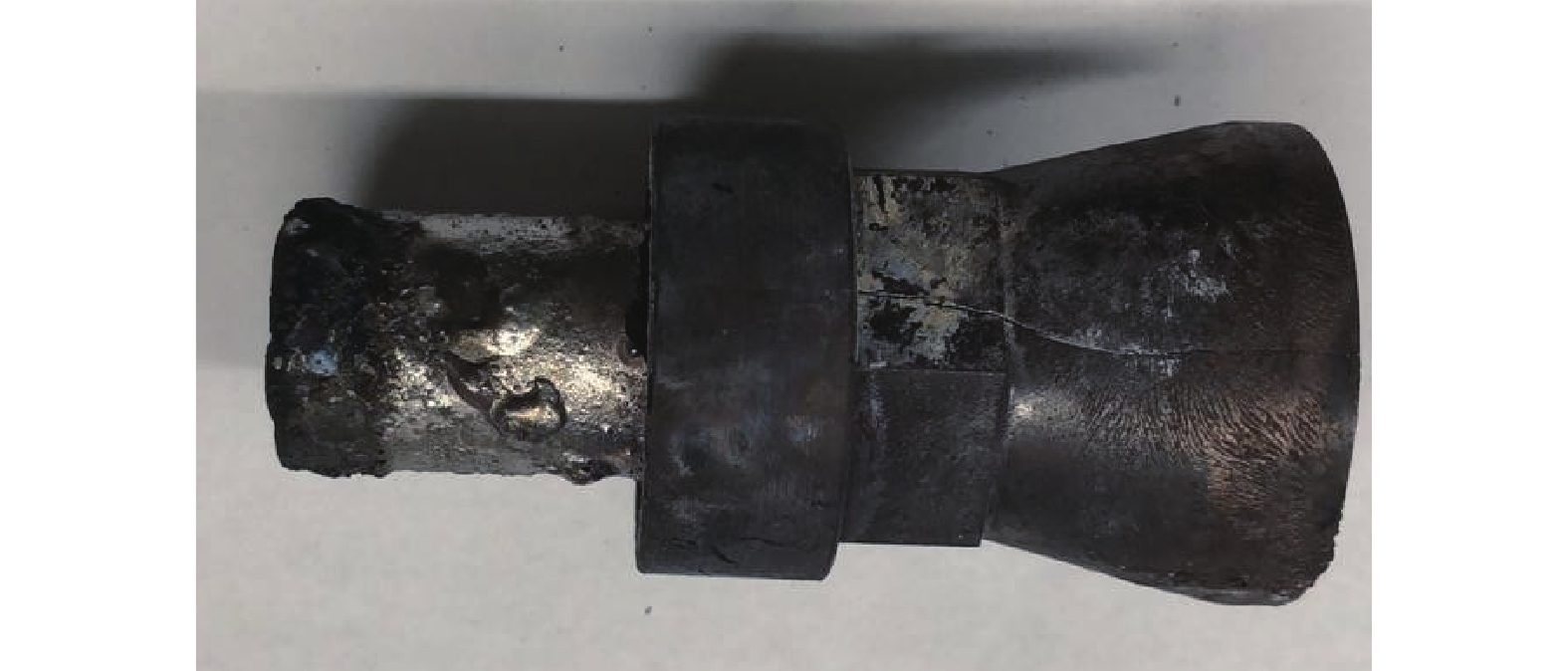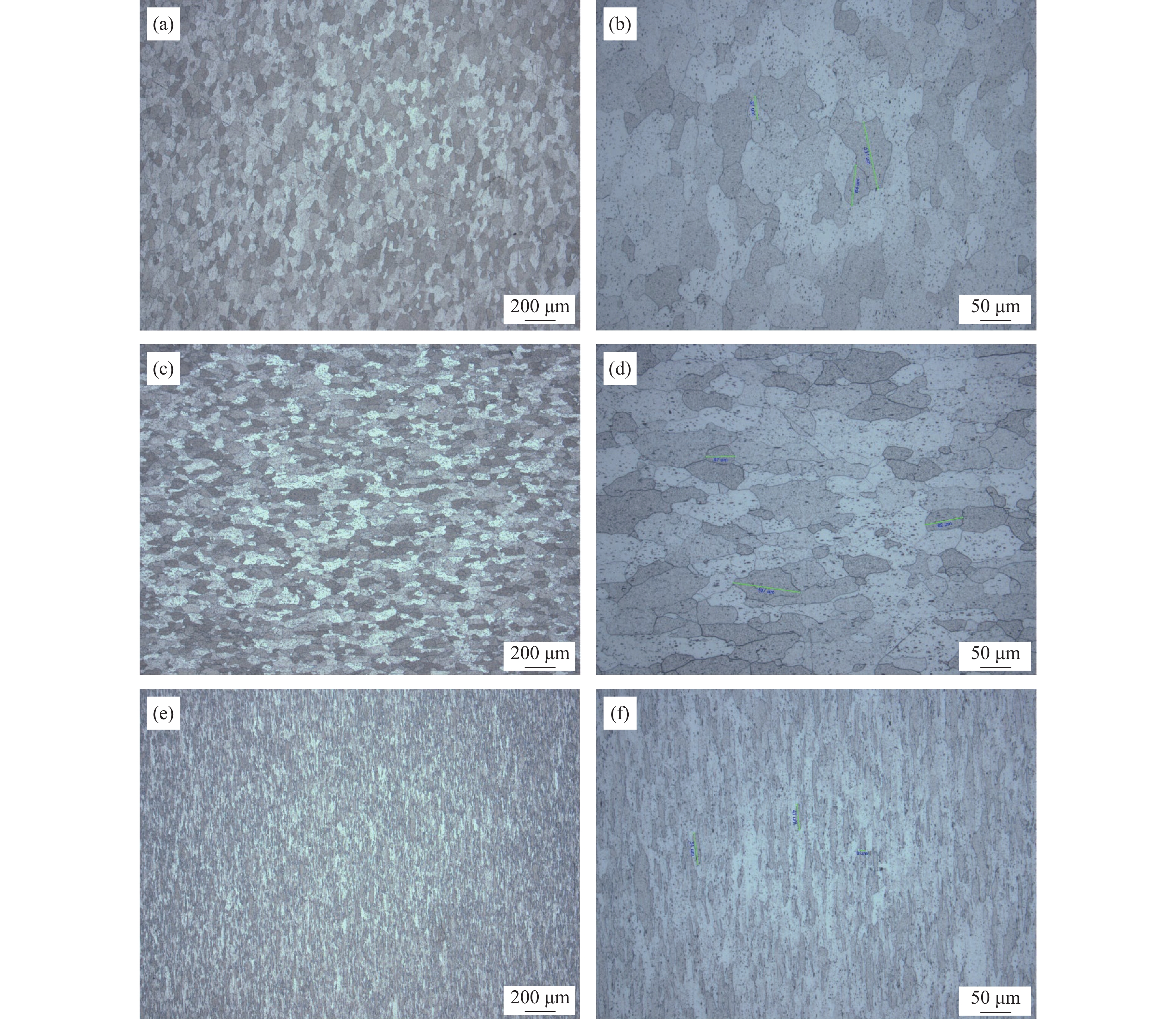Fracture morphology and microstructure analysis of Mo–La nozzles for solid rocket motor
-
摘要: 通过固体火箭发动机地面热试车实验获得烧蚀后的钼镧喷管试样,对比分析了烧蚀前后试样的金相组织,在常温和1000 ℃条件下进行了钼镧材料的力学性能实验。结果表明:对于工作时间2.1 s的固体火箭发动机中搭载使用的钼镧喷管,内型面形状完整,尺寸无明显变化,抗烧蚀性能表现良好;烧蚀前后金相组织对比显示晶粒发生再结晶,特别是喷口及喷管中部工作温度高的位置,形貌变化明显,由细长的纤维状变为等轴晶趋势。镧的氧化物粒子对钼起到了韧化作用,合金试样1000 ℃高温和常温下断口出现颈缩和韧窝,高温下韧窝深浅差异更大,抗拉强度和伸长率有所下降。Abstract: The ablated Mo–La nozzle samples were obtained through the ground thermal test of solid rocket motor. The metallographic structures of the samples before and after ablation was compared and analyzed. The mechanical properties of Mo–La materials were tested at room temperature and 1000 ℃. The results show that the Mo–La nozzles used in solid rocket motor with working time of 2.1 s have the complete inner profile shape, no significant change in size, and good ablation resistance. The metallographic structure before and after ablation reminds the grain recrystallization, especially at the high working temperature position in the middle of nozzle and nozzle, and the morphology changes obviously from the slender fiber to the equiaxed grain. The molybdenum is toughened by the lanthanum oxide particles, the necking and dimple appear on the fracture surface of alloy samples at 1000 ℃ and room temperature, the dimple depth is greater at high temperature, and the tensile strength and elongation decrease.
-
钛合金是一种比强度高、耐蚀性能优异的合金材料, 对航空航天、汽车制造等领域发挥了重要的作用。但在实际应用过程中, 钛合金存在抗高温氧化与耐磨性不足的问题, 严重限制了该合金材料在高温载荷领域的进一步推广应用[1-3]。为了进一步提升钛合金的各项性能, 大多数研究人员主要通过喷焊、气相沉积、激光熔覆等工艺对钛合金进行表面处理[4-6]。其中, 激光熔覆技术可以在不改变钛合金性能的前提下使涂层间形成良好冶金结合状态, 对于钛合金材料摩擦性能的提升起到了明显的促进作用[7-8]。现阶段, 许多学者在Ti4合金耐磨性方面主要是通过增加该材料的表面硬度来实现。不过, 加入钛合金中的TiN、WC、VC等硬质相颗粒在860℃温度下却存在容易被空气氧化的问题[9-10]。例如, Feng等[11]利用激光熔覆处理工艺对Ti5合金表面进行处理, 生成包含增强相TiNi/Ti2Ni基涂层, 并对该涂层进行了表征, 得到涂层中形成了具有均匀分布状态的陶瓷相颗粒, 从而增加了合金材料的耐磨性。Guo等[12]则利用激光熔覆技术对Ni Cr BSi/WC–Ni合金涂层进行了处理, 制得了具有良好耐磨性能的合金涂层。齐鸣等[13]采用激光熔覆工艺使高温合金表面生成MoSi2/Al涂层, 之后在1050℃下对该涂层实施了耐高温氧化性测试, 当涂层中含有的Al比例上升后, 生成的氧化膜中的Al2O3会显著提高熔覆层的耐高温氧化性。余鹏程等[14]对Ti4合金表面进行激光熔覆处理后得到了含有增强相Al3Ti/Ni Ti基涂层, 研究得到当涂层内含有的Al3Ni2脆性颗粒数量增加后, 涂层耐磨性发生了降低的现象。
到目前为止, 大部分学者都是将研究重点集中于通过激光熔覆处理方法来提升钛合金的耐磨性方面, 但很少有文献报道关于钛合金耐高温抗氧化性能的改善内容[15]。本文主要通过激光熔覆处理工艺使Ti4合金表面生成Ni Al Si涂层, 并深入探讨了在860℃温度下该涂层对抗氧化性提升的效果及其作用机理。
1. 实验材料及方法
1.1 实验原料
实验用原料为Ti4合金, 试样尺寸40 mm×40 mm×8 mm, 用砂纸打磨试样熔覆面, 充分去除表面氧化膜。选择80Ni–40Al–20Si复合粉末作为熔覆材料, 采用QM-3SP04型行星球磨机对该粉末进行12 h的球磨处理。
1.2 涂层制备
先在Ti4合金试样涂覆一层甲基纤维素黏结剂, 再铺设一层厚度为1.5 mm的混合粉末, 再将其放入120℃的干燥箱内进行2 h的保温。本实验在DLS-980.10-3000C半导体激光器上完成激光熔覆过程, 工艺参数为: 输出功率2 kW, 扫描速度3.5 mm·s-1, 光斑大小5 mm×2.5 mm。
1.3 涂层性能测试
通过线切割方式得到熔覆层的截面金相试样, 并对该试样进行了X射线衍射(X-ray diffraction, XRD) 表征。利用S-4700型场发射扫描电镜(scanning electron microscopy, SEM) 对涂层微观组织进行了观察, 同时在该电镜附带的能谱仪(energy disperse spectroscope, EDS) 上表征了涂层的各元素组成情况。利用HMF1400-50高温电阻炉测试其抗高温氧化性能, 并计算单位面积对应的质量变化情况。对经过氧化处理的合金与涂层进行金相观察。
2. 结果与分析
2.1 合金涂层显微组织
从图 1 (a) 中可以看到涂层横截面的扫描电子显微形貌。根据图 1 (a) 可知, 在涂层内也没有观察到裂纹结构, 只有少数气孔存在。从图 1 (b) 中可以看到在Ti4和涂层的结合部位形成了熔合线, 可以推断涂层和钛合金之间形成了良好的冶金结合状态。同时还可以观察到在涂层的底部区域形成了众多的柱状晶, 这主要是因为受到凝固冷却的影响, 钛合金垂直的方向上具有最快的冷却速率, 从而导致涂层的下部晶粒优先从垂直钛合金表面的方向上开始生长。图 1 (c) 是对应于图 1 (b) 的放大图, 可以明显看到该图包含了块状区域A与网状区域B两种, 对这些区域进行能谱测试可知, 区域A中的元素类型包括Ti与Si, 两者的原子数分数比接近5:3, 可见该区域的成分主要是Ti5Si3金属间化合物; 对区域B进行元素分析得到该区域包含Ni与Al两种元素, 其原子数分数比接近3:2, 进一步结合X射线衍射图谱可知, 区域B的成分主要是Al3Ni2金属间化合物, 因此可以推断涂层中包含了Ti5Si3与Al3Ni2两种主要成分。
表 1 图 1 (c) 中区域A和区域B能谱分析Table 1. EDS analysis of area A and area B in Fig. 1 (c)区域 原子数分数/% Ti Ni Al Si A 44.28 22.18 5.48 28.06 B 23.54 42.18 30.02 4.26 2.2 高温抗氧化性能及机理
从表 2中可以看到对钛合金与合金涂层进行高温氧化测试得到的试样单位面积质量变化值, 其中钛合金的单位面积质量增加值显著高于合金涂层, 可见合金涂层的耐高温氧化性能优于钛合金。经过40 h的恒温氧化处理后, 试样单位面积质量增加了24.4 mg·cm-2, 可见在860℃温度下, Ti4合金的表面发生了明显的氧化过程, 此时形成的氧化膜也不能有效抑制氧原子的扩散过程。其中, 在初期高温氧化阶段, 合金涂层具有很快的氧化速率, 当氧化时间不断增加后, 合金涂层的氧化速率降低, 因此可以推断合金涂层表面氧化膜具有降低氧化速率的作用; 经过40 h的高温氧化处理后, 粉末合金涂层的质量增加值是2.19 mg·cm-2, 比Ti4合金的耐高温氧化性能提高了12倍左右。
表 2 Ti4合金和合金涂层高温氧化(860℃) 测试结果Table 2. High temperature oxidation test results of Ti4 alloy and alloy coating at 860℃样品 单位面积质量变化/(mg·cm2) 5 h 10 h 20 h 30 h 40 h Ti4 合金 2.40 4.40 9.20 16.70 24.40 合金涂层 1.82 1.90 2.02 2.11 2.19 Ti4合金与粉末合金涂层在860℃温度下进行40 h的氧化处理后, 对其表面氧化层进行X射线衍射测试得到如图 2所示的谱图。从图 2的测试谱图中可以发现, Ti4合金的氧化层基本包含Al2O3与TiO2两种物相成分, 并且TiO2的衍射峰强度显著高于Al2O3, 说明氧化膜主要是由TiO2构成。由于在860℃下V2O5的挥发性较高, 因此在X射线衍射谱图中未观察到该氧化物的衍射峰, 同时氧化膜也因为V2O5的挥发而形成多孔结构, 使氧原子更易向膜内扩散, 导致合金耐高温氧化性降低。
图 3 (a) 为在860℃下进行40 h氧化处理后得到的Ti4合金横截面扫描电子显微形貌, 可以发现此时Ti4合金表面出现了较严重腐蚀的情况, 生成的氧化膜表现出了明显的热脆性特征, 较易从表面发生脱落的现象。对Ti4合金的氧化膜微观形貌进行分析可知, 氧化膜主要由许多球形颗粒与柱状物构成, 根据能谱分析(表 3) 可知, 柱状物成分主要是TiO2。在TiO2的形核与生长期间, 还会形成少量的Al2O3, 使氧化膜中形成众多微孔, 这种不连续的氧化膜结构不能发挥有效阻止氧原子扩散的作用, 不利于提高合金的耐高温氧化性。
图 3 (b) 为在860℃下进行40 h氧化处理后得到的合金涂层氧化膜扫描电子显微形貌。从图中可知, 合金涂层与氧化膜之间保持紧密结合状态, 未看到有脱落情况出现。对该涂层进行能谱分析(表 3) 可知, 其表面氧化膜中的元素主要为O、Al, 同时还有部分Si、Ni、Ti, 因此可以推断该氧化膜的主要成分时Al2O3, 此外还含有部分NiO、SiO2、TiO等。因为Al2O3能够形成致密的连续结构, 起到明显抑制O元素扩散的效果, 使合金涂层耐高温抗氧化性能获得显著提高。
3. 结论
(1) Ti4合金和合金涂层的结合部位形成了熔合线, 可以推断合金涂层和钛合金之间形成了良好的冶金结合状态。同时还可以观察到在涂层的底部区域形成了众多的柱状晶, 涂层中包含了Ti5Si3与Al3Ni2两种主要成分。
(2) 钛合金的单位面积质量增加值显著高于合金涂层, 可见合金涂层的耐高温氧化性能优于钛合金。经过40 h的高温氧化处理后, 粉末涂层的质量增加值是2.19 mg·cm-2, 比Ti4合金的耐高温氧化性能提高了12倍左右。
(3) 在860℃下进行40 h氧化处理得到的合金涂层与氧化膜之间保持紧密结合状态, 未看到有脱落情况出现, 氧化膜的主要成分是Al2O3。
-
表 1 钼镧合金的化学成分(质量分数)
Table 1 Chemical composition of the Mo–La alloys
% La2O3 Fe Ni Si Ca Mg Al Mo 0.6200 0.0025 0.0015 ≤0.0020 ≤0.0020 ≤0.0020 ≤0.0020 余量 表 2 力学性能参数表
Table 2 Mechanical properties
试样编号 密度 / (g·cm−3) 硬度,HV10 室温抗拉强度 / MPa 室温伸长率 / % 1000 ℃抗拉强度 / MPa 1000 ℃伸长率 / % ML 10.18 228 675 49 210 17 -
[1] 林冰涛, 余小波, 张保红, 等. 固体火箭发动机用W8Cu钨渗铜喉衬抗烧蚀性研究. 兵器装备工程学报, 2020, 41(12): 214 DOI: 10.11809/bqzbgcxb2020.12.040 Lin B T, Yu X B, Zhang B H, et al. Study on ablation resistance of W8Cu tungsten infiltrated copper nozzle throat liner for SRM. J Ordn Equip Eng, 2020, 41(12): 214 DOI: 10.11809/bqzbgcxb2020.12.040
[2] 朱阳, 孙建涛, 闫联生, 等. 固液火箭发动机钨渗铜喉衬的烧蚀形貌及性能研究. 功能材料, 2019, 50(6): 6206 Zhu Y, Sun J T, Yan L S, et al. Morphology and anti-ablation properties of the W–Cu alloy throat in the hybrid rocket motor test. J Funct Mater, 2019, 50(6): 6206
[3] 弓艳飞, 曲斌瑞, 梁艳明, 等. 粉末粒度对发动机钼护板力学性能的影响. 粉末冶金工业, 2021, 31(1): 78 Gong Y F, Qu B R, Liang Y M, et al. Study on effect of powder particle size on mechanical properties of molybdenum shield. Powder Metall Ind, 2021, 31(1): 78
[4] 刘澜涛, 陈冠宇, 易黎明, 等. 固体火箭发动机炭/炭复合材料喉衬烧蚀行为研究. 炭素技术, 2021, 40(3): 31 Liu L T, Chen G Y, Yi L M, et al. Study on the ablation mechanism of C/C composite throat for solid rocket motor. Carbon Technol, 2021, 40(3): 31
[5] 王攀, 杨涤心, 魏世忠, 等. 液–液掺杂钼镧合金中的稀土相研究. 稀有金属材料与工程, 2010, 39(12): 2185 Wang P, Yang D X, Wei S Z, et al. Study on RE phase of Mo–La alloy prepared by a liquid-liquid doping method. Rare Met Mater Eng, 2010, 39(12): 2185
[6] 刘仁智, 安耿, 杨秦莉, 等. 钼–铼–镧合金微观组织及力学性能研究. 粉末冶金技术, 2018, 36(6): 429 Liu R Z, An G, Yang Q L, et al. Microstructures and mechanical properties of Mo–Re–La alloy. Powder Metall Technol, 2018, 36(6): 429
[7] 韩强. 钼镧合金板材料舟的研制及其断裂行为分析. 稀有金属材料与工程, 2012, 41(9): 1564 DOI: 10.3969/j.issn.1002-185X.2012.09.013 Han Q. Preparation of La-doped molybdenum boat and analysis on fracture behavior. Rare Met Mater Eng, 2012, 41(9): 1564 DOI: 10.3969/j.issn.1002-185X.2012.09.013
[8] 张威. 纯钼及钼镧合金轧制工艺及组织性能研究[学位论文]. 沈阳: 东北大学, 2014 Zhang W. Rolling Process Microstructure and Property of Pure Molybdenum and Molybdenum Lanthanum Alloy [Dissertation]. Shenyang: Northeastern University, 2014
[9] 曲家惠, 魏岩峻, 卢凤生, 等. 双钴1-a推进剂作用下钼喉衬烧蚀性能研究. 稀有金属, 2014, 38(4): 622 Qu J H, Wei Y J, Lu F S, et al. Erosion performance of molybdenum nozzle insert with double base propellant of cobalt 1-a. Chin J Rare Met, 2014, 38(4): 622
[10] 居炎鹏, 王爱琴. 钼合金研究现状. 粉末冶金工业, 2015, 4(25): 58 Ju Y P, Wang A Q. Current research status of Mo alloys. Powder Metall Ind, 2015, 4(25): 58
[11] 王林, 孙军, 孙院军, 等. 掺杂方式对Mo–La2O3合金组织和力学性能的影响. 稀有金属材料与工程, 2007, 36(10): 1827 Wang L, Sun J, Sun Y J, et al. Effects of doping methods on microstructure and mechanical properties of Mo–La2O3, Rare Met Mater Eng, 2007, 36(10): 1827
[12] 李世磊, 胡平, 段毅, 等. 掺杂方式对钼合金组织与力学性能影响的研究进展. 材料导报, 2020, 34(9): 9132 DOI: 10.11896/cldb.18120082 Li S L, Hu P, Duan Y, et al. Research status of the effect of doping methods on microstructure and mechanical properties of molybdenum alloy. Mater Rep, 2020, 34(9): 9132 DOI: 10.11896/cldb.18120082
[13] 林小辉, 张国君, 张纳纳, 等. Mo–Si合金室温及高温拉伸力学性能研究. 稀有金属材料与工程, 2012, 41(6): 1021 DOI: 10.3969/j.issn.1002-185X.2012.06.016 Lin X H, Zhang G J, Zhang N N, et al. Tensile properties of Mo–Si alloys at room and elevated temperature. Rare Met Mater Eng, 2012, 41(6): 1021 DOI: 10.3969/j.issn.1002-185X.2012.06.016
[14] 董帝, 王承阳, 康聚磊, 等. 变形加工工艺对钼棒力学性能和显微组织的影响. 粉末冶金工业, 2019, 29(2): 50 Dong D, Wang C Y, Kang J L, et al. Effects of deformation modes on the mechanical properties and microstructure of molybdenum rods. Powder Metall Ind, 2019, 29(2): 50
[15] 武洲, 王娜, 吴吉娜, 等. 钼钨合金烧结致密化行为. 粉末冶金技术, 2021, 39(3): 234 Wu Z, Wang N, Wu J N, et al. Sintering densification behavior of molybdenum tungsten alloys. Powder Metall Technol, 2021, 39(3): 234
[16] Feng P F, Fu J B, Zhao H, et al. Effects of doping technologies on mechanical properties and microstructures of RExOy doped molybdenum alloys. Met Powder Rep, 2016, 71(6): 437 DOI: 10.1016/j.mprp.2016.07.001
[17] 孙露, 张继峰, 邱天旭, 等. 锻造温度对含钼粉末热锻合金显微组织及力学性能的影响. 粉末冶金技术, 2020, 38(3): 174 Sun L, Zhang J F, Qiu T X, et al. Effect of forging temperature on microstructure and mechanical properties of powder hot-forged alloy contained molybdenum. Powder Metall Technol, 2020, 38(3): 174
[18] 姚惠龙, 熊宁, 王玲, 等. 循环热处理对 93W–5Ni–2Fe高比重钨合金冲击韧性的影响. 粉末冶金技术, 2021, 39(3): 269 Yao H L, Xiong N, Wang L, et al. Effect of cyclic heat treatment on impact toughness of 93W–5Ni–2Fe tungsten heavy alloy. Powder Metall Technol, 2021, 39(3): 269
-
期刊类型引用(0)
其他类型引用(4)




 下载:
下载:










